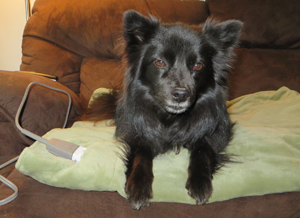dog on heating pad DeGioia

File heating pad injuries under “Things that should never happen, but do.”
If you think a heating pad is a safe way to provide warmth and comfort to your pet (or to you), think again.
Yes, the same heating pad that you snuggle up with on a cold winter’s night can pose a massive threat to your pet. I have seen horrific injuries from them too many times and felt the need write about it and let pet owners know what they can do to prevent this kind of thing from happening to their pets.
A heating pad can cause very painful and difficult-to-treat burns in both people and pets. I have seen many pets receive serious burns, some requiring many painful and costly surgeries or skin grafting over several weeks to return to function. All of these injuries are eminently avoidable.
Heating pad burns usually happen either at home or in a veterinary hospital. First, let’s go over the home version as that’s the one you’ll have a little more control over.
A few rules (one *never* and one *always*) to remember when using a heat pad or heated bed to provide warmth for your pet:
- Never set them on anything but the lowest setting
- Always use a layer of padding like a folded blanket or towel between the pad and your pet.
Make sure your pet can get up and move off of a heating pad if they get too hot. Very young animals, paralyzed or otherwise immobile pets, and those who may not be fully aware are at the most risk from getting burned by a heating pad. Placing the pad on top of the animal (keeping the above rules in mind) might also help avoid injury, since the pressure of lying atop a heating pad contributes to injury.
This brings us to the second scenario: heating pads used in veterinary hospitals.
Pets undergoing surgery or anesthesia lose body heat rapidly. And the smaller they are, the faster they get cold. Aside from being an unpleasant sensation, hypothermia can increase infection rate, prolong anesthetic recovery and lead to many other complications. When I have a patient under anesthesia, I work hard to keep their body temperature as close to normal as I can.
Several medical devices are on the market for this purpose, and they do a good job of safely maintaining a patient’s body temperature. My favorite is a gizmo called a Bair Hugger (get it?) that uses flowing warm air to gently surround a patient with minimal to no risk of burns.
Some hospitals use electric heating pads for this purpose. Many use them safely and have never had any problem. But on occasion, either through improperly setting them too high or not using enough padding, patients still get badly burned. For this reason, I am not a fan of veterinary hospitals using heating pads on patients, especially when good options like the Bair Hugger exist. Anesthetized patients can’t move off the heat, and can’t tell you when they are getting burned. We are supposed to make our patients better, not further injure them.
If you have a pet undergoing surgery or recuperating in a veterinary hospital, it might be good to verify with the doctors or staff that no heating pads will be used and that another method such as a Bair Hugger is being used – or that heating pads are used on the low setting with appropriate padding.
Being warm and cozy is one of life’s small pleasures and I don’t want to deny any pets the comfort of a warm spot to curl up in, or a better anesthetic experience. But injuries from heating pads are avoidable if you and your vet use them correctly. Don’t let your pet become one more sad statistic: use heating pads the right way if you use them at all.